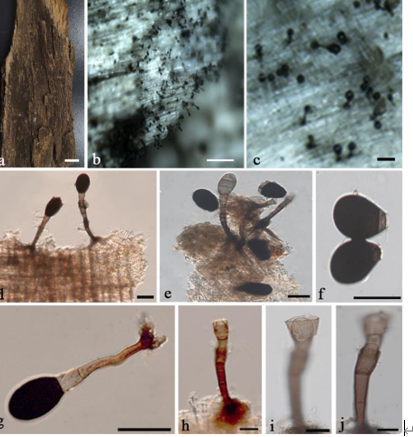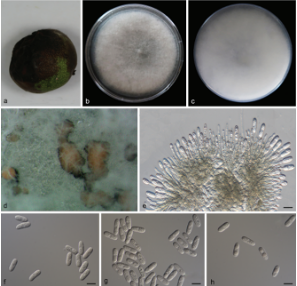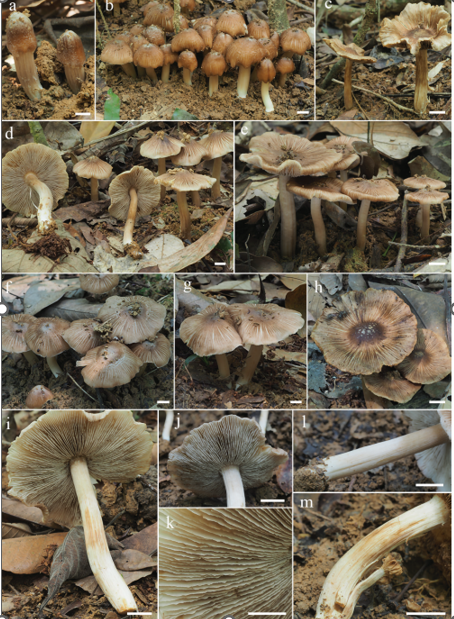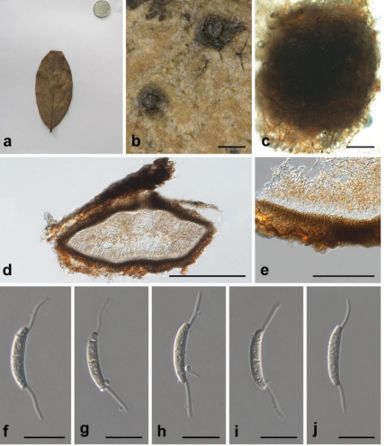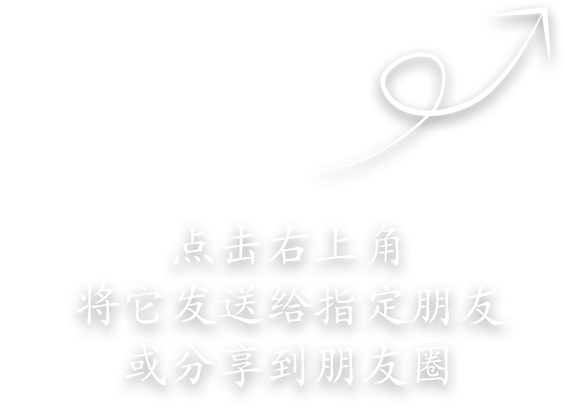Nemania lishuicola Y .H. Pi & Q.R. Li, sp. Nov2021
MycoBank No: 840090
Holotype: GMBC0065, ex-type living culture; KUN-HKAS 112673, isotype)
Morphological description
Sexual morph: Stromata pulvinate, attached to substrate along entire area of the base, containing one to several perithecia, frequently confluent, 1.5–4 mm long × 1–2 mm wide × 0.5–1 mm thick, with conspicuous perithecial mounds, carbonaceous between the perithecia, surface dull black and slightly shiny at maturity, the interperithecial tissue blackish, carbonaceous; not releasing a coloured pigment in 10% KOH. Perithecia 0.7–0.95 mm diam. × 0.65–0.85 mm high, subglobose to depressed-spherical. Ostioles coarsely papillate in discoid areas, ostiolar area blackish, shiny, frequently flattened, usually around a circle of white tissue. Asci 150–300 × 7–12 μm (av. = 200 × 9 μm, n = 30), 8-spored, unitunicate, cylindrical, long-stipitate, spore-bearing parts 95–130 µm long, apically rounded with a J+ apical apparatus, 2–3 × 2–3.5 µm (av. = 2.5 × 3 µm, n = 30), tubular with a faint upper rim. Ascospores 12.5–17 × 5–8.5 μm (av. = 15 × 6.5 μm, n = 30), uniseriate, unicellular, ellipsoid-inequilateral, with broadly rounded ends, smooth, brown to dark brown, with a conspicuous, straight germ slit spore-length to slightly less than spore-length on the flattened side; lacking a sheath and appendage; perispore indehiscent in 10% KOH.
Asexual morph: Undetermined.
Cultures: Colonies grow on PDA, a diameter of 6 cm after one week at 25 °C, white, velvety to hairy, zonnate, rosette, high convex in centre, dense, white to cream from above, white irregular edge with light yellow to slightly yellow at centre from the below. Not sporulating on OA nor on PDA.
Habitat: on dead bark of Quercus sp
Distribution: l. China, Yunnan Province, Changning County: Lancang River Nature Reserve (25°01'30.75"N, 99°35'21.53"E, altitude: 2608 m),
GenBank Accession: its MW851886; rpb2 MW836065 ; tubulin MW836033 ; catin MW836048 . its MW851887; rpb2 MW836066; tubulin MW836034; catin MW836049.
Notes: Phylogenetic analyses of combined ITS, rpb2, β-tubulin and α-actin genes (Fig. 1) show that N. lishuicola has a close relationship with N. bipapillata with high support values (100 MLBP, 1% BYPP). Morphologically, N. lishuicola differs from N. bipapillata by its larger ascospores (12.5–17 × 5–8.5 μm vs. 10.5–13.5 × 4.5–6 μm) (Miller 1961; Ju and Rogers 2002).
Reference: [1] Song, Y. J. , & Li, S. Q. . (2008). A taxonomic study of chinese nematogmus species (araneae, linyphiidae). Organisms, diversity, & evolution(4), 8.
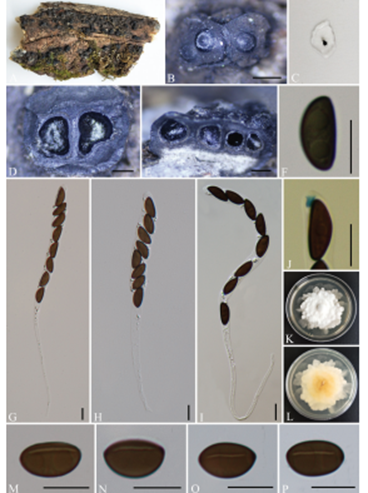
Nemania lishuicola (GMB0065, holotype) A type material B stromata on the surface of host C pigments in 10% KOH D transverse sections of stromata E longitudinal sections of stromata F ascospore with indehiscent perispore in 10% KOH G–I asci with ascospores J ascus apical apparatus (stained in Melzer’s Reagent) K, L colonies on PDA (K-upper, L-lower) M–P ascospores. Scale bars: 0.5 mm (B, D, E); 10 μm (F–J, M–P)


